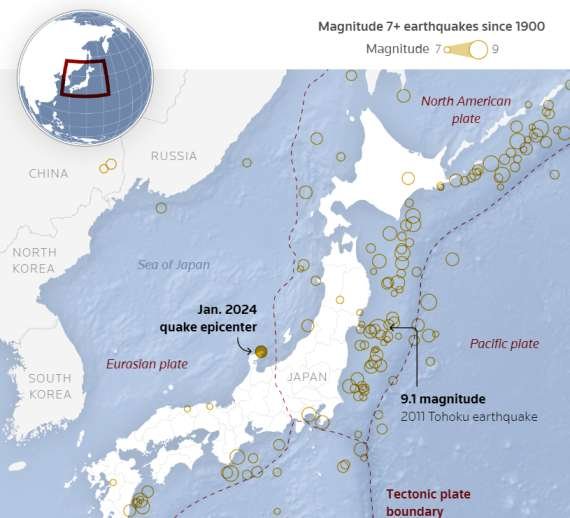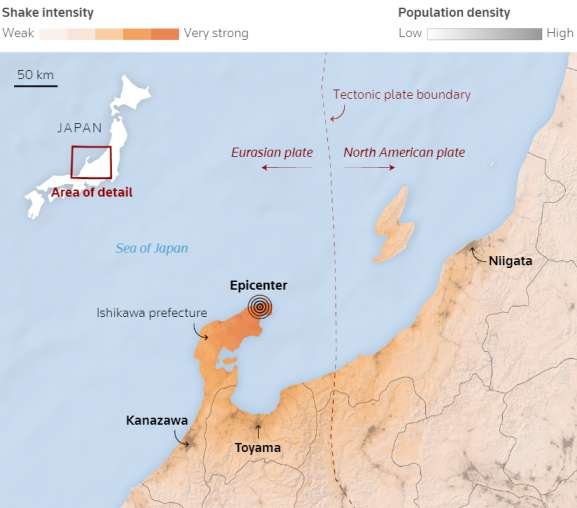Japan’s Remarkable Dedication to Rescuing New Year’s Day Quake Survivors. Japan is facing a race against time to assess and address the aftermath of a powerful earthquake that struck its west coast on New Year’s Day. The quake, with a preliminary magnitude of 7.6, has left at least eight people dead, causing extensive damage to buildings, roads, and infrastructure.

Unprecedented Earthquake Hits Japan’s West Coast
On Monday afternoon, a magnitude 7.6 earthquake struck Japan’s Ishikawa prefecture, marking the strongest earthquake to hit the country’s western coast in decades. The impact was particularly significant as large-intensity earthquakes are more common along the eastern coast, close to the Japan Trench, where the Pacific and North American tectonic plates meet. Japan’s Determination to Save Quake Survivors”
Widespread Devastation and Urgent Rescue Efforts
The earthquake prompted residents in coastal areas to flee to higher ground as tsunami waves, reaching about 1 meter (3.3 ft), battered Japan’s western seaboard. Thousands of army personnel, firefighters, and police officers from across the country are mobilized to the worst-hit area in the remote Noto peninsula. However, rescue efforts are impeded by badly damaged and blocked roads, with one airport closing due to runway cracks.
PM Call to Action: Japan’s Unyielding Efforts in Rescuing
“The search and rescue of those impacted by the quake is a battle against time,” emphasized Prime Minister Fumio Kishida during an emergency disaster meeting on Tuesday. He highlighted the difficulty rescuers face in reaching the northern tip of the Noto peninsula due to wrecked roads. Helicopter surveys revealed numerous fires and extensive damage to buildings and infrastructure.
Casualties and Challenges
Public broadcaster NHK reported eight deaths in the hard-hit town of Wajima. At the same time, nearby Suzu faced challenges with doctors unable to reach a hospital relying on a backup generator for power. The national police reported six confirmed deaths, with the fire and disaster management agency stating that 19 people were in a state of cardiac arrest during the New Year’s Day Quake.
Ongoing Tremors and Future Threats

Over 90 tremors have been detected since the initial quake, according to the Japan Meteorological Agency. Which warns of the possibility of more strong shocks in the coming days in Japan. The earthquake’s impact reverberated beyond the worst-hit areas, leading to supply chain interruptions and leaving shelves in convenience stores empty in Toyama City.
International Support and Evacuation
President Joe Biden expressed the United States’ readiness to provide necessary assistance to Japan’s New Year’s Day Quake rescuing. The Japanese government ordered over 97,000 people to evacuate their homes, utilizing sports halls and school gymnasiums as emergency shelters. While many returned home as tsunami warnings were lifted, around 33,000 households remained without power in Ishikawa prefecture, and water supply issues persisted in the northern Noto peninsula.
Sensitive Time for Japan’s Nuclear Industry
New Year’s Day Quake Rescue is going on. The earthquake occurs at a sensitive time for Japan’s nuclear industry. which is still grappling with the aftermath of the 2011 earthquake and tsunami that led to nuclear meltdowns in Fukushima. The Nuclear Regulation Authority reported no irregularities at Nuclear plants along the Sea of Japan, including those with active reactors. However, concerns linger, especially for towns devastated by the previous disaster and Quake Rescue.
Impact on Industries
Conclusion
Japan is grappling with the aftermath of a powerful earthquake that struck its west coast on New Year’s Day. The race against time continues as rescue efforts face challenges posed by damaged infrastructure and ongoing tremors. International support is pouring in, and the nation remains vigilant, considering the sensitive backdrop of its nuclear industry.
